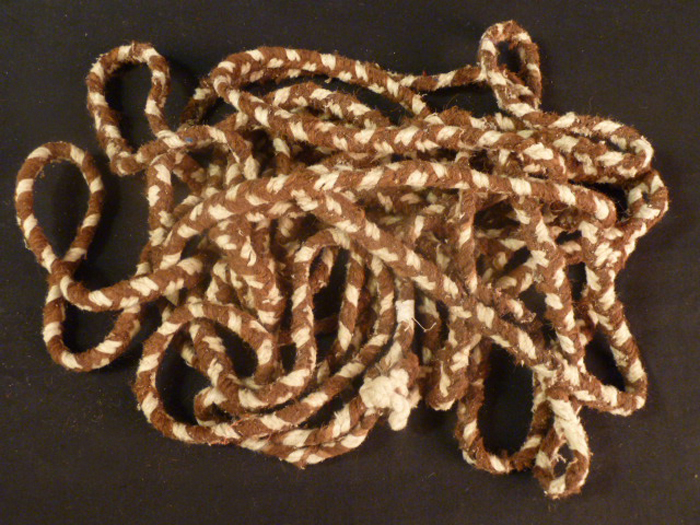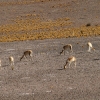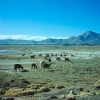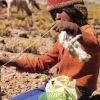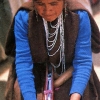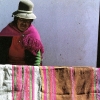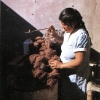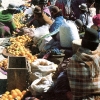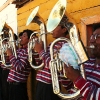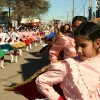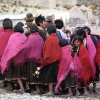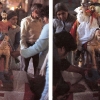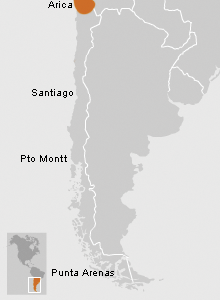La religiosidad aymara es un sistema de base sincrética donde se funden una cosmovisión y ritualidad tradicional las llamadas costumbres , y las creencias católicas, la religión. Ambas conforman un todo integrado, denominado la liturgia. Este sincretismo se expresa especialmente en fiestas comunitarias como la de los santos patronos, la Semana Santa y la de Todos los Santos.
Es un culto anual, coherente al paso del año, centrado y estructurado en torno a la Tierra. Poseen una visión mitologizada, humanizada y sacra del entorno geográfico, componente importante de su mundo simbólico y de una ideología que da sentido a su entorno, posicionándolos y responsabilizándolos en su interacción cotidiana con él. En un primer sustrato de creencias, el más antiguo, encontramos el culto a los espíritus de las grandes montañas, los Achachilas, Mallkus y/o Talla o Aviadores, que son masculinos o femeninos, y tienen enorme poder e injerencia en la vida humana pues son los administradores del clima; a la Pachamama, la Virgina o Madre Tierra, organismo generador de toda la vida (fauna, flora y seres humanos); y el Amaru o serpiente que representa los cursos de agua. Esta triada es tanto referencia del origen, abundancia y distribución del agua como donadora de vida, y es además patrón de ordenamiento del espacio económico y ecológico en el que el aymara se desenvuelve.
De la misma forma, este trío de espíritus jerarquiza la estructura social y político-económica de la sociedad aymara: el centro social, político y religioso de las diferentes etnias, su pueblo-capital, está en las zonas altas de pastoreo, en la mitad superior oriente. Todo lo que compone la Pachamama está vivo, tiene nombre, razón y un destino. Hay lugares que pueden ser protectores y otros, perjudiciales, todos merecen respeto y algunos adoración y sacrificios. Existen lugares fuertescomo las cumbres o Piru partes y las fuentes de aguas. Los sitios arqueológicos son sectores de respet o ya que ahí se hallan los antepasados, llamados gentiles o abuelos. Por otro lado, la tripartición mitológica de la que hemos hablado es también eco-ideológica, se debe aspirar y permanecer en un Tinku, un equilibrio en permanente acomodo para seguir siendo tal.
La cosmología aymara fue sufriendo cambios, primero a causa de la dominación inka y luego española. De esta forma, la triada autóctona Mallku-Pachamama-Amaru mutó a una cristianizada Arajpacha-Akapacha-Manqhapacha (cielo-Tierra-infierno) que expresa la subordinación aymara con respecto a la sociedad colonial y neo-colonial. Por otra parte, su visión del tiempo es cíclica, definida por las estaciones climáticas que a su vez determinan el ciclo laboral-festivo. Todo esta inserto en un macrociclo de tiempo y espacio conocido como Pacha, en constante renovación por medio de revoluciones llamadas Kuti. Es una concepción rítmica y orgánica del tiempo que adapta hechos históricos y mitológicos introduciendo una visión lineal e histórica de él: el origen de la era del sol, la conquista y colonialismo y la conciencia de un futuro Kuti. Además de la práctica católica, la religión, se continúa celebrando el culto tradicional andino, las costumbres. Estas son: las de producción, las de pasaje (primer corte de pelo o ruytucho, matrimonio y fallecimiento) y las ligadas a la salud de hombres, plantas y animales. Cada jefe de familia, dueño de chacra o ganado debe dirigir el culto periódico familiar, sea el pago a la Tierra, el floreo del ganado, la construcción, inauguración o sanación de una casa o corral, etc. Respecto a sus patrones funerarios, existen distintos tipos de sepulturas: en cistas de piedra; directamente en la tierra, dentro y fuera de las casas; en fosas cilíndricas; o en pequeños aleros rocosos. También destacan los monumentos funerarios conocidos como chullpa que son estructuras de adobe en forma de torre, algunas bellamente pintadas, usadas como tumbas de las élites gobernantes durante la época pre-incaica.








































